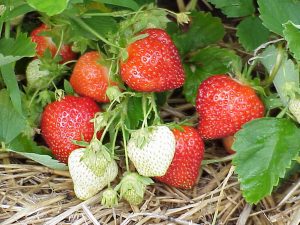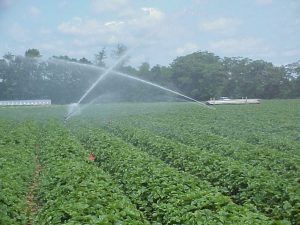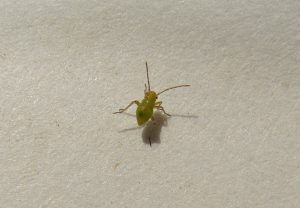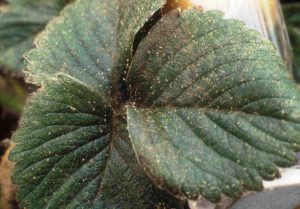Strawberry IPM Newsletter No. 3 – June 1, 2018
 Strawberry IPM Newsletter No. 3 – June 1, 2018
Strawberry IPM Newsletter No. 3 – June 1, 2018
Click on photos to enlarge.
MITES AND TARNISHED PLANT BUG NUMBERS RISING
Predicted Rains May Call for Protection Against Gray Mold Infection
Berry Growers Twilight Meeting
Wednesday, June 6, 2018 at 5:00 p.m.
Pineland Farm in New Gloucester, Maine
Situation:
Many parts of the state are very dry for this time of year. While this will help reduce fungal disease infections, it is important to remember that fruit size can be negatively affected by a lack of moisture. As fruit are developing, the plants need one to two inches of water per week to prevent plant stress and assure good fruit size. If the weather is not providing this moisture, growers should irrigate to supply it. It is best to irrigate in the morning so that the plants have time to dry off before evening. This will reduce the chance of fungal diseases taking advantage of the wet conditions. Early fields in southern Maine have green fruit, with the seeds just starting to separate. Later fields are just coming into full bloom. Growers are getting ready to apply their second or third fungicide spray for gray mold before the predicted wet weather this weekend.

Reminder: Twilight Meeting Wednesday June 6, Pineland Farm, 752 Mayall Road, New Gloucester, Maine 04260. Pineland Farms has some of the largest strawberry fields in the state, all of which are irrigated. They also have significant plantings of raspberries and high bush blueberries. Their main crops, in addition to strawberries, are sweet corn, which is mechanically harvested, and pumpkins. Join us for a tour and a chance to look at some of the equipment and irrigation engineering used at this unique farm. We will also have an update on the berry pest situation around the state. The meeting will run from 5:00 p.m. to 7:00 p.m. We anticipate that two pesticide applicator recertification credits will be awarded for the meeting. Hold the date!
Strawberry bud weevil or “clipper” activity continues to be low in late fields that still have flower trusses with closed buds. Once the primary (king) and secondary blossoms have opened, it is doubtful that clipper can cause significant economic harm to the crop. This week, only one field in Dresden was over the threshold of 1.2 or more clipped buds per two feet of row. Raspberry and blackberry growers should be scouting for clippers on these crops. Past experience has shown that when clipper emerge late, as they have this year, they tend to be more prolific on brambles, although they do not appear to cause as much significant injury to these crops.

Tarnished plant bug activity has been spotty and mostly low in fields scouted this week. We have started finding very small nymphs in flower clusters, indicating that more may be showing up soon. These nymphs are very small (2 mm) and active, and will drop off the blossoms when disturbed. It is important to scout for them regularly, as they can appear very quickly. We tap 30 flower clusters in each field over a white plate and look for any nymphs that have fallen onto it. The threshold is 4 or more flower clusters infested with nymphs per 30 sampled. Insecticide options for tarnished plant bug include malathion, Assail®, Brigade®, Bifenture®, Dibrom®, Danitol®, and PyGanic®.
White grubs are the larvae of scarab beetles, including Japanese beetles, Asiatic garden beetles and European chafers. Similar to the root weevils, these grubs feed on the roots of strawberry plants, but tend to be larger, have noticeable legs and a swollen back end. White grubs are pupating now, and adults are beginning to emerge. These will soon be laying eggs at the base of the strawberry plants and a new generation of grubs will appear during the late summer and fall. Soil drenches with Admire Pro® or Platinum® can provide control of grubs in new plantings or following renovation in older plantings. Parasitic nematodes may also be applied in the spring and/or fall. See the New England Small Fruit Management Guide for details.

Two-spotted spider mite populations appear to be building in many fields this week. This is to be expected under warm, dry weather conditions. Fields in Limington, Bowdoinham and New Gloucester had mite numbers over the recommended spray threshold, and most fields had at least some mites present. It is important to scout for mites regularly. If 25% of leaves sampled (e.g. 15 out of 60) have any mites, a spray should be applied. Chemical control options for two-spotted spider mites include Acramite®, Savey®, Zeal®, Portal®, Vendex®, Oberon®, Brigade®, and Danitol®. Be sure to use enough liquid and pressure in the spray to get good coverage on the undersides of the leaves.
Slugs may be a problem in some fields this season. Moist conditions and mulch encourage the presence of these mollusks. Slugs usually feed at night, leaving large holes in the leaves and tunnels in the ripening fruit. Baits such as Deadline® and Sluggo® offer some control of slugs, but should be used prior to fruit ripening. Pay close attention to label instructions and precautions. Baits should also be applied to the fields in mid-September if slugs have been a problem, to reduce egg-laying.
Deer: Feeding damage by deer has been observed in several fields this spring. Rows of plants look weak or dead and have few, if any leaves, although the root system may look healthy. When deer feed on plants during the winter the plants often die, as they are exposed and the crowns are damaged. By the time the mulch is removed, the plants just look dead, and any evidence left by the deer has washed away. Deer will also feed in the spring, eating leaves and sometimes damaging crowns. If deer are a problem in your area, it is best to fence the planting before they start feeding in it. Temporary electric fencing is usually adequate if set up correctly in a timely manner.
Diseases: It is still important to protect the flowers and developing fruit against infection by spores of the gray mold fungus, Botrytis cinerea. Late blooming varieties are still at a susceptible stage for infection, and varieties now beyond bloom may need additional protection if we experience significant periods of cool, damp weather.
Leather rot (Phytopthora cactorum) can be a problem in fields that experience heavy downpours of rain anytime during the bloom and fruit development period. Spores are splashed up by the rain and infect flowers and fruit, causing them to develop off colors and bad flavor. Sunken black lesions on the fruit may also be visible. Applying straw mulch between the rows to prevent berries from touching the soil and reducing soil splashing onto the berries can reduce infections. Additionally, foliar sprays of Aliette®, Prophyt® or Phostrol® applied during bloom and fruit development can prevent leather rot when there has been excess moisture in a field, especially those with a history of this problem.
Powdery mildew: We haven’t seen symptoms of powdery mildew on foliage yet, but it may become a problem with continued warm, dry conditions. Look for upward cupping of the leaves and reddish streaking or lesions on the leaf and flower stems. Consider using a fungicide that will control powdery mildew, such as captan + Topsin-M®, or Pristine® if you’re still spraying for gray mold.
Leaf spot has been showing up in a few late, susceptible varieties. Look for small purple spots with white centers on the leaves. The symptoms are often first visible on the older, lower leaves but then spread throughout the foliage. Spots or lesions may also appear on the leaf and flower stems. Severe infections can weaken plants, reducing fruit size, yield, and winter survival. If you see leaf spot in your field, you should consider using a fungicide that will provide control as part of your spray program for gray mold. Products such as captan, Luna Sensation®, Mervion® and Pristine® have activity on both diseases.
Sincerely,
David T. Handley
Vegetable and Small Fruit Specialist
Highmoor Farm, P.O. Box 179, 52 US Route 202, Monmouth, ME 04259, 207.933.2100
UMaine Extension Diagnostic Research Lab, Pest Management Unit, 17 Godfrey Drive, Orono, ME 04473, 1.800.287.0279
Where brand names or company names are used it is for the reader’s information. No endorsement is implied nor is any discrimination intended against other products with similar ingredients. Always consult product labels for rates, application instructions and safety precautions. Users of these products assume all associated risks.
The University of Maine is an equal opportunity/affirmative action institution.
